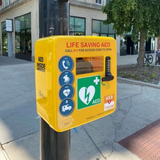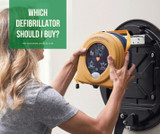How does the Zoll defibrillator work?
Defibrillators are used when someone suffers a sudden cardiac arrest. These can occur to anyone at anytime regardless of age, sex, ethnicity or gender. It is really important to have a defibrillator installed in your workplace, local gym, supermarket and even outside in your local town or village. This is because we unfortunately, do not know when a sudden cardiac arrest can occur.
If a defibrillator is used as soon as a person falls ill, their chances of survival can be as high as 90%. Without a defibrillator however, this statistic is marginally lower and the chance of survival is usually not promising. All defibrillators are designed to be used by anyone regardless of whether they are medical professionals or not. This means that both a paramedic and passer-by on the street can deliver life-saving care when needed the most. If you did nothing and waited for the paramedics to arrive - it would more than likely be too late.
When using a defibrillator, it is important to also perform CPR. This means that oxygenated blood is still being pumped around the body to vital organs such as the brain. Before doing this, you must call for an ambulance. Whilst you are performing CPR, the electrode pads placed on the victims chest will be scanning the heart.
How does a ZOLL defibrillator work?
A ZOLL defibrillator works in the same way as other defibrillators on the market. They scan the heart to determine whether a shock is needed and if so, will deliver a shock to help restore the heart back to it’s natural rhythm. The goal of a shock is to deliver the appropriate amount of current to the heart, at the correct time.
ZOLL defibrillators and AEDs feature an intensely developed Rectilinear Biphasic waveform technology, also known at RBW. It is the only biphasic waveform that has demonstrated clinically superior results when compared to monophasic waveforms when it compared against a host of other defibrillators on the market.
ZOLL defibrillators deliver more average current to high impedance patients, delivering shocks at 200 joules when compared to any other bisphasic waveform - even those that have higher energy settings. This shows that ZOLL defibrillators provide a higher energy, better performing shock when compared to any other defibrillator on the market.
What is the difference between monophasic and biphasic defibrillators?
A monophasic shock will deliver a shock in one direction, through one electrode straight to another. A biphasic shock on the other hand, means the current runs from the first electrode to the second electrode through the patient’s heart. The biphasic shock is seen as a more convenient, accurate and effective. It is also known to prevent further damage to the heart.
How do you use a defibrillator?
- When you see someone suffering a sudden cardiac arrest, call the emergency services immediately. Send someone else to find the nearest defibrillator. If you are on your own, go and find one yourself, after calling 999.
- If the patient is unresponsive and you cannot find a pulse, begin to perform CPR. This ensures blood is pumped around the body to the vital organs.
- Once you have the defibrillator, place the electrode pads on the chest, following the guidance provided. When these are attached, they will begin to scan the heart’s rhythm and will ask you to push a button in order for it to begin analysing. Not ever sudden cardiac arrest victim will require a show - the defibrillator will always tell you what to do next. If it is automatic it will deliver a shock without you doing anything, if it isn’t it will ask you to press a button to administer the shock. A defibrillator will never shock unless required.
- Once the shock has been delivered, the defibrillator will continue with it’s steps and you should continue CPR. It will measure how effectively you are performing CPR and will give real time feedback if you need to adjust what you are doing.
- Carry on providing CPR until the emergency services arrive and follow all prompts from the defibrillator until a medical professional comes to take over.
- If you notice signs of life, you can stop CPR and monitor breathing to see if anything changes.
To shop a range of ZOLL defibrillators, take a look here.
Recent Posts
-
Empowering Communities: The Lifesaving Impact of CPR on Restart a Heart Day
Every year, on and around October 16th, an important event takes place - Restart a Heart Day. This a …16th Oct 2023 -
Which home defibrillator?
80% of all out of hospital cardiac arrests occur at home. Defibrillators are often available in loca …4th Dec 2022 -
Which defibrillator should I buy?
There are many defibrillators available on the market and it can become overwhelming knowing which o …4th Nov 2022




